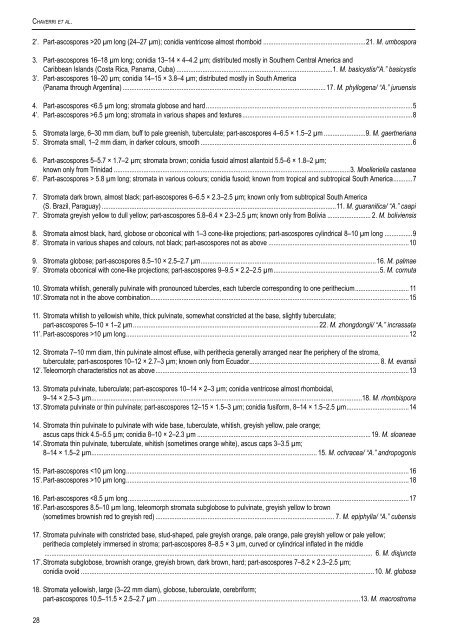Moelleriella, and Samuelsia - CBS
Moelleriella, and Samuelsia - CBS
Moelleriella, and Samuelsia - CBS
- No tags were found...
You also want an ePaper? Increase the reach of your titles
YUMPU automatically turns print PDFs into web optimized ePapers that Google loves.
Ch av e r r i e t a l.2’. Part-ascospores >20 µm long (24–27 µm); conidia ventricose almost rhomboid............................................................21. M. umbospora3. Part-ascospores 16–18 µm long; conidia 13–14 × 4–4.2 µm; distributed mostly in Southern Central America <strong>and</strong>Caribbean Isl<strong>and</strong>s (Costa Rica, Panama, Cuba)...........................................................................................1. M. basicystis/“A.” basicystis3’. Part-ascospores 18–20 µm; conidia 14–15 × 3.8–4 µm; distributed mostly in South America(Panama through Argentina)...................................................................................................................... 17. M. phyllogena/ “A.” juruensis4. Part-ascospores 6.5 µm long; stromata in various shapes <strong>and</strong> textures...................................................................................................85. Stromata large, 6–30 mm diam, buff to pale greenish, tuberculate; part-ascospores 4–6.5 × 1.5–2 µm.........................9. M. gaertneriana5’. Stromata small, 1–2 mm diam, in darker colours, smooth...........................................................................................................................66. Part-ascospores 5–5.7 × 1.7–2 µm; stromata brown; conidia fusoid almost allantoid 5.5–6 × 1.8–2 µm;known only from Trinidad.........................................................................................................................................3. <strong>Moelleriella</strong> castanea6’. Part-ascospores > 5.8 µm long; stromata in various colours; conidia fusoid; known from tropical <strong>and</strong> subtropical South America...........77. Stromata dark brown, almost black; part-ascospores 6–6.5 × 2.3–2.5 µm; known only from subtropical South America(S. Brazil, Paraguay)........................................................................................................................................11. M. guaranitica/ “A.” caapi7’. Stromata greyish yellow to dull yellow; part-ascospores 5.8–6.4 × 2.3–2.5 µm; known only from Bolivia.......................... 2. M. boliviensis8. Stromata almost black, hard, globose or obconical with 1–3 cone-like projections; part-ascospores cylindrical 8–10 µm long.................98’. Stromata in various shapes <strong>and</strong> colours, not black; part-ascospores not as above..................................................................................109. Stromata globose; part-ascospores 8.5–10 × 2.5–2.7 µm..................................................................................................... 16. M. palmae9’. Stromata obconical with cone-like projections; part-ascospores 9–9.5 × 2.2–2.5 µm..............................................................5. M. cornuta10. Stromata whitish, generally pulvinate with pronounced tubercles, each tubercle corresponding to one perithecium............................... 1110’. Stromata not in the above combination.....................................................................................................................................................1511. Stromata whitish to yellowish white, thick pulvinate, somewhat constricted at the base, slightly tuberculate;part-ascospores 5–10 × 1–2 µm........................................................................................................... 22. M. zhongdongii/ “A.” incrassata11’. Part-ascospores >10 µm long...................................................................................................................................................................1212. Stromata 7 –10 mm diam, thin pulvinate almost effuse, with perithecia generally arranged near the periphery of the stroma,tuberculate; part-ascospores 10–12 × 2.7–3 µm; known only from Ecuador........................................................................... 8. M. evansii12’. Teleomorph characteristics not as above...................................................................................................................................................1313. Stromata pulvinate, tuberculate; part-ascospores 10–14 × 2–3 µm; conidia ventricose almost rhomboidal,9–14 × 2.5–3 µm............................................................................................................................................................18. M. rhombispora13’. Stromata pulvinate or thin pulvinate; part-ascospores 12–15 × 1.5–3 µm; conidia fusiform, 8–14 × 1.5–2.5 µm....................................1414. Stromata thin pulvinate to pulvinate with wide base, tuberculate, whitish, greyish yellow, pale orange;ascus caps thick 4.5–5.5 µm; conidia 8–10 × 2–2.3 µm..................................................................................................... 19. M. sloaneae14’. Stromata thin pulvinate, tuberculate, whitish (sometimes orange white), ascus caps 3–3.5 µm;8–14 × 1.5–2 µm.................................................................................................................................. 15. M. ochracea/ “A.” <strong>and</strong>ropogonis15. Part-ascospores 10 µm long...................................................................................................................................................................1816. Part-ascospores
















